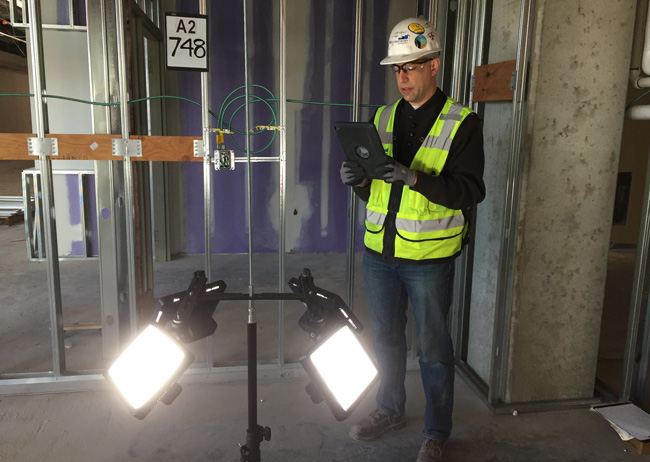One of the biggest challenges for a new facility owner is maintaining the building after construction is complete. Having an efficient and informational way to understand what systems are built into the walls and above the ceilings can be extremely useful.
In the past, mechanical, electrical and plumbing (MEP) system documentation has been recorded with individual photos. To adequately capture a standard room, it required six to ten photos. Smaller rooms, where the camera’s field view is smaller, required even more images. Using this documentation process is time-consuming, as is locating the correct image at a later date.
To address these issues, Mortenson is using a panoramic camera to generate 360-degree photo spheres of each room at the new Hennepin County Medical Center (HCMC) Specialty Center. The photo is then filed in the project records by the room number, making it easy to find later. Each photo documents the MEP systems that are behind all the walls and above the ceiling.
“This formerly cumbersome task of taking multiple photos for each room has turned into a one step process,” said Mortenson’s Integrated Construction Coordinator Chris Bubser. “We plan to implement this on future projects as it improves the user experience for the facilities team and speeds-up the documentation process, giving us more time to focus on other aspects of construction.”

Integrated Construction Coordinator Chris Bubser documents each room using a 360-camera. The camera is placed in the center of the room on a tripod with lights and is operated remotely by a cellphone or tablet.
“We are excited about the 360 degree photos and see great value in having well organized, easily accessible images of the building,” said HCMC Senior Facilities Manager Fred Ames. “We do not have photos of the MEP systems behind the walls of our current buildings. At times I wish we had this documentation as we have repeatedly cut holes in walls and used a borescope to find out what is inside before completing maintenance tasks.”
On a project like HCMC’s Specialty Center, where there is an upwards of 1,300 rooms, this innovative process has saved countless hours in documentation and provides the facilities team an easy way to understand the systems that are out of sight.